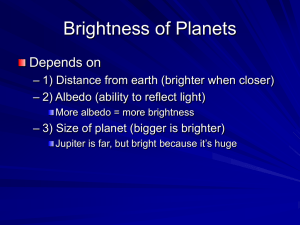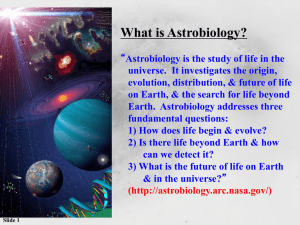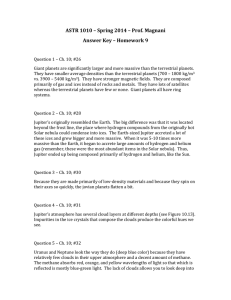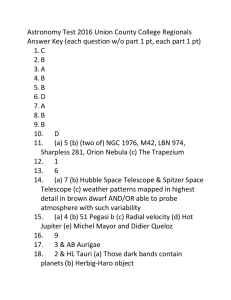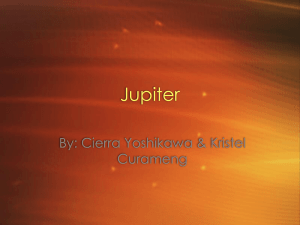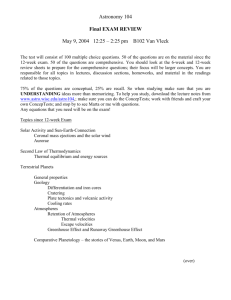The Three-Body Problem: Finding Chaos in the Cosmos
advertisement
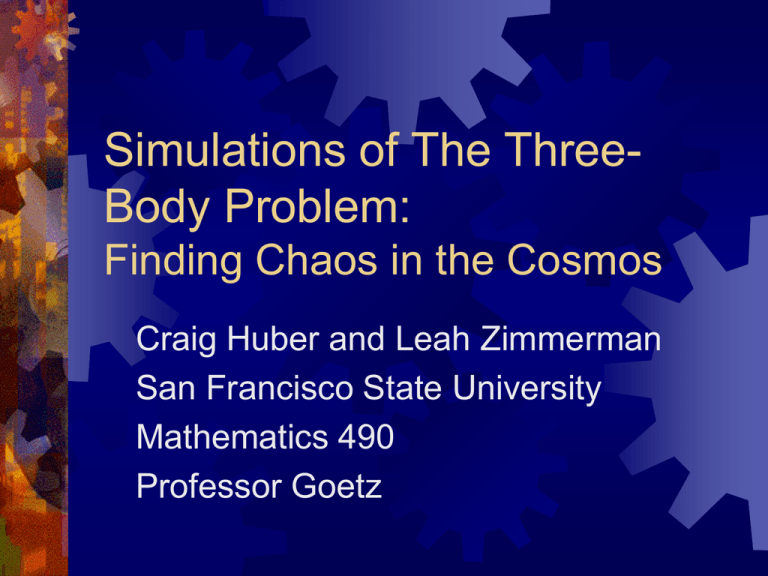
Simulations of The ThreeBody Problem: Finding Chaos in the Cosmos Craig Huber and Leah Zimmerman San Francisco State University Mathematics 490 Professor Goetz Early Studies of Planetary Motion Ptolemy (2nd century C.E.) of the Early Greeks developed a geocentric scheme for the solar system. Earth remains stationary in the center while the other planets rotate around it. Had to use epicycles (planets move around a circle whose center moves around another circle centered on the earth) to explain their motion. Nicolaus Copernicus (1473-1543) proposed a heliocentric (Sun-centered) scheme. Sun Earth Early Studies of Planetary Motion Johannes Kepler (1571-1630) interpreted Tycho Brahe’s (1546-1601) accurate observational data. He came up with three laws: All planets move in elliptical orbits having the Sun at one focus. A line joining any planet to the Sun sweeps out equal areas in equal times. The square of the period of any planet about the Sun is proportional to the cube of the planet’s mean distance from the Sun. Kepler’s laws are empirical! Early Studies of Planetary Motion Later, Sir Isaac Newton derived Kepler’s Laws from his Law of Universal Gravitation. Unified the previously separate terrestrial and celestial mechanics. A particle is attracted to any other with a force directly proportional to the product of their masses and inversely proportional to the square of the distance between them. F -F m1m2 F G 2 r The Three-Body Problem The N-body problem in n dimensions has (n2+3n+2)/2 classical integrals of motion: n from the total momentum, n from the position of the center of mass, and n(n-1)/2 from the total angular momentum, and finally, 1 from the energy. Because 2nN-1 integrals of motion were necessary to integrate the N-body problem, there are in general not enough classical integrals if N>2. Already the Newtonian 3body problem in n=2 contains all the complexity a dynamical system can have. Solving the Three-Body Problem Instead of solving the three-body problem analytically, we wrote a software program to simulate three masses under mutual gravitational attraction. Assumption 1: Each mass moves linearly in a small amount of time (~ 0.01 year for planets in our solar system). Assumption 2: The three masses are restricted to move in a coplanar fashion (Lagrange). Pseudocode The attractive force between two masses in orbit is proportional to the both the masses and inversely proportional to the square of the distance between them. Gm1m2 Gm1m2 F12 2 r ( x1 x2 ) 2 ( y1 y2 ) 2 Where G is Newton’s gravitational constant: m3 G 6.726 10 kg s 2 And the acceleration of mass 1 due to mass 2 is found directly 11 Gm2 a12 x1 x2 2 y1 y2 2 Pseudocode Once the accelerations are broken down into their x and y components, the velocities and positions can be found by recursive elementary physics calculations. The velocity of mass 1 in the x-direction is vx1 vo ax1t The position of mass 1 in the x-direction, where xo is the position of mass 1 one iteration prior. 1 x1 xo vx1t a x1t 2 2 A Real World Example: The Earth, Moon, and Sun Fig. 1 The Moon (red) orbiting the Earth (green) which is orbiting the Sun (blue), in the x-y plane. (b) x-x’ phase plot. (c) y-y’ phase plot. (a) (a) (b) (c) A Real World Example: The Earth, Venus, and Sun Fig. 2 Venus (red) and the Earth (green) orbiting the Sun (blue), in the x-y plane. (b) x-x’ phase plot. (c) y-y’ phase plot. (a) (a) (b) (c) Question: does the presence of other planets in our solar system perturb the motion of the earth? Answer: Yes! Especially the more massive planets, like Jupiter, affect the orbit of the earth in small ways. Earth Sun Jupiter Perturbations in the Earth’s orbit due to the presence of Jupiter. Fig. 2 Fig. 3 Earth’s orbit with Jupiter present (T=1 yr, ∆t=.01 yr). Earth’s orbit without Jupiter present (T=1 yr, ∆t=.01 yr). Question: What would happen if Jupiter were a little closer to the earth? Answer: As Jupiter’s initial radius from the Sun approaches Earth’s radius from the Sun, the Earth’s orbit becomes a toroid. At one point, if Jupiter gets too close to the Earth, their orbits become unstable. Chaos due to the presence of Jupiter (with Jupiter closer) http://www.physics.sfsu.edu/~lzimmer/chaos/EJS1.avi http://www.physics.sfsu.edu/~lzimmer/chaos/EJS2.avi Fig. 3 Fig. 4 Jupiter at an initial distance of 1.1 AU (T=11 yrs, ∆t=.01 yr). Jupiter at an initial distance of 1.105 AU (T=11 yrs, ∆t=.01 yr). Chaos due to the presence of Jupiter (MJ is greater) http://www.physics.sfsu.edu/~lzimmer/chaos/EJS3.avi http://www.physics.sfsu.edu/~lzimmer/chaos/EJS4.avi Fig. 3 Fig. 4 Mass of Jupiter is 100 times its original, now at 31,700 Earth masses (T=11 yrs, ∆t=.01 yr). The mass of Jupiter is now 1,000 its original mass (T=11 yrs, ∆t=.01 yr). Chaos for fun Chaos for fun References Diacu, Florin and Holmes, Philip. Celestial Encounters: The Origins of Chaos and Stability. Princeton University Press, Princeton, New Jersey. 1996. Halliday, David, Kenneth Krane, and Robert Resnick. Physics vol. I, 4th Ed. John Wiley & Sons, Inc., New York. 1992. Leimanis, E. and Minorsky, N. Dynamics and Nonlinear Mechanics. John Wiley & Sons, Inc., New York. 1958. Marion, Jerry and Stephen Thornton. Classical Dynamics of Particles and Systems, 3rd Ed. Harcourt Brace & Company, Fort Worth. 1995. Peterson, Ivars. Newton’s Clock: Chaos in the Solar System. W. H. Freeman and Company, New York. 1993.

